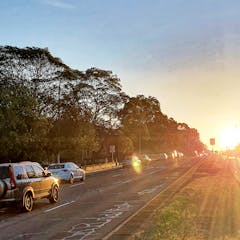
Articles on Healthy Liveable Cities
Displaying 1 - 20 of 28 articles

The centralisation of planning power is exactly what Sydney doesn’t need. While not perfect, the commission broke the mould of top-down, siloed planning and broadened the focus across the whole city.

Cities around the world are reducing traffic speeds and improving access to local services and activities by public transport, cycling and walking. They are now reaping the many ‘slow city’ benefits.

NSW is developing a comprehensive new planning policy with the goal of creating healthy places. A new study finds those people who work as placemakers want these goals embedded in laws and budgets.

The pervasive impacts of infrastructure projects on public health are often overlooked. New research is teasing out the many ways Melbourne’s level-crossing removals will affect people’s health.

Walking all parts of Melbourne before and after the pandemic hit was eye-opening. It brought home just how much change is possible if we wish for a better, more sustainable way of living.

If Australia created more age-friendly neighbourhoods — which really are more liveable for everyone — then we wouldn’t have to rely so heavily on underfunded, substandard aged-care homes.

The differences in sentiment in areas of high and low neighbourhood amenity have been clear under Melbourne’s tough COVID restrictions. It’s further evidence of the impacts of inequity on well-being.

Proposals to improve the capital’s urban design and density must also take account of the city’s unique streetscapes.

Before the pandemic, the country was making great strides towards creating more compact, sustainable and liveable cities.

We are all finding out about neighbourhood liveability as we stay home for the coronavirus lockdown. What we learn about local strengths and weaknesses can help us improve our communities in future.

Sleep might be a key factor in the link between greener neighbourhoods and better health. A new study shows living in an area with more tree canopy improves people’s odds of getting enough sleep.

The Spanish city is remaking urban neighbourhoods by limiting through traffic in superblocks that give priority to pedestrians and street activities, not cars.

The research has been done. The evidence is in. We know how to create cities that are sustainable, liveable and affordable. But we have yet to apply that knowledge widely across Australian cities.

Future Earth Australia is working to create a long-term national plan of transformation for our cities. As part of this, everyone in Australia is invited to have their say in a survey.

Australia has well established urban design guidelines, whereas many Chinese cities don’t have any – and it shows. But Australia can also learn from China.

When a city scores badly on “liveability”, it can put serious pressure on city leaders – but do these rankings really help improve life for local people?

Rather than mourn the end of a seven-year reign as ‘world’s most liveable city’, Melbourne could raise its sights to become more liveable, healthy and sustainable for all who live in the city.

When we plan a better future for an increasingly urbanised world, we need to be aware that more than half of all children now live in the tropics. That calls for solutions with a tropical character.

If the menu of potential activities that do us good is made to look uninviting or challenging, we are more likely to choose the easier but less healthy option.

Regional areas are expanding, and yet not enough attention is being paid to improving rail access to capital cities. This affects the liveability of the areas.





